Best
for Beginners
-
Overall: Brazilwood Bow With Unbleached Horsehair
-
Best Feature: With A Padded Lightweight Carrying Soft Case
-
TedScore™: 9/10
Best
Cello Pick
-
Overall: Lightweight composite tailpiece
-
Best Feature: Hand-Carved From Spruce And Maple Wood
-
TedScore™: X/10
Best
Violin Pick
-
Overall: With An Extra Bridge And Adjustable Shoulder Rest
-
Best Feature: Crafted In Different Sizes
-
TedScore™: 9/10
Walking through the halls of a music school, you often hear passionate discussions about “Cello vs Violin.” I completely understand the dilemma!
The cello and the violin are essential in orchestral music, each telling its unique story steeped in history and bursting with character. While the cello’s deep, resonant tones bring a sense of calm, the violin sings with a grace that can make your heart flutter.
Choosing between the two isn’t just about picking an instrument; it’s about finding a new friend who will harmonize with the rhythm of your life. So, if you’re grappling with the decision between the bass clef’s champion and the treble clef’s hero, don’t worry.
I’m here to guide you through the differences and help you find the perfect match that aligns with your musical aspirations. Who knows, by the end, you might be ready to pick up the bow and let your heart sing!
History and Origins
The cello is the second-largest string instrument in the family. It was developed around the early 16th century in Italy and was built by Andrea Amati in 1538 for the famous Medici family.
Also, Andrea Amati developed the violin in Italy in 1560, and its appearance and structure remained the same. Over time, the violin family evolved into four distinct instruments: the violin, the viola, the cello, and the double bass.
The Cello
The cello is played with a bow and is usually seated when performing. The strings of a cello are thicker and longer than a violin's, producing a lower-frequency sound. The instrument has been used in various genres of music, including classical, jazz, and rock. Its versatility and unique sound make it a beloved tool among musicians and music lovers.
The Violin
The violin is associated with Western and Eastern music types, and its history and origins can be traced back to many different cultures and musical traditions. Its small size and sweet, high-pitched sound make it a versatile and popular instrument, and it continues to be a favourite among musicians and music lovers alike.
The Similarities of
Cello and Violin

Violin and cello are similar in their form and look. Both have an hourglass shape and four strings. They belong to the same family of instruments, called the violin family, which includes the viola and double bass. They also have similar tones.
The Differences Between Cello and Violin
Have you ever wondered about the difference between cello and violin? These instruments are part of the string family but have distinct characteristics that set them apart.
Size and Physical Characteristics
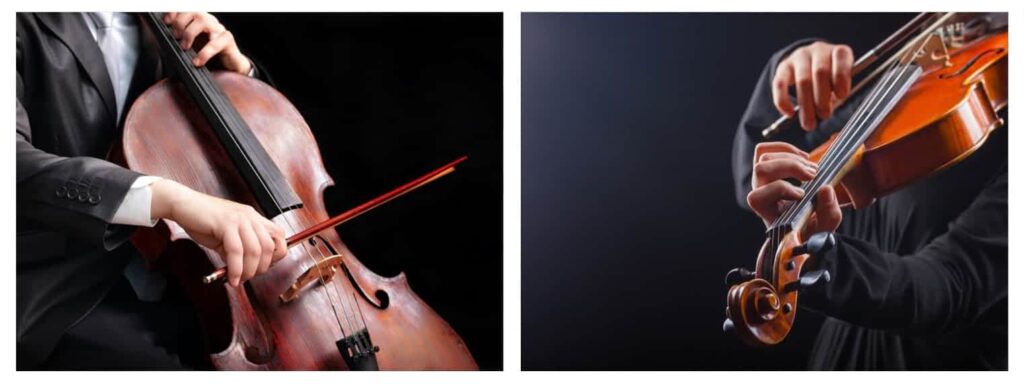
A full-size cello stands about 4 feet tall and has a body that is roughly 30 inches long, while a full-size violin is only about 2 feet tall and has a body that is roughly 14 inches long. The cello has four while the violin has tuned in fifths strings.
The cello’s strings are typically made of gut, synthetic materials, or steel, while the violin’s strings are typically made of steel, gut, or synthetic materials.
Range and Sound
The cello has a lower range than the violin, meaning it can produce deeper and richer sounds. Unlike the violin, it has a higher range, producing brighter and more piercing sounds.
Playing Techniques and Styles
The cello is played while seated, and the musician presses down on the strings with the left hand. Musicians played by a sweeping stroke and plucking the strings produce a deep and resonant sound. The violin is played while standing, and the musician holds the instrument with the left hand to press down and the right hand to draw the bow across the strings.
The bowing technique for the violin involves short and quick strokes, which produce a bright and clear sound.
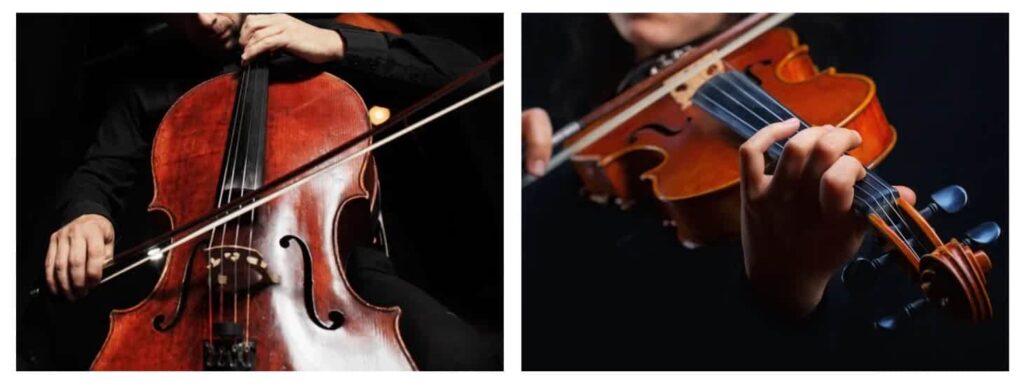
Cellists use vibrato to create an expressive and emotional sound.
The violin is also used in classical music but is known for its versatility and ability to adapt to various genres. It’s frequently used in orchestras, chamber ensembles, and solo performances.
Repertoire
The cello is often associated with classical music and has a rich repertoire of solo, chamber, and orchestral works. The violin has a much broader repertoire that spans various genres and styles.
Violin and cello can also be used in chamber music and orchestral settings.
Strings
The strings of a cello are thicker and longer than a violin’s, allowing for a lower-frequency sound when tied off at the lower ends of the instrument.
In contrast, the violin has four strings tuned from low to high notes; C2, G2, D3, and A3, while the cello has strings tuned an octave lower. Cello strings comprise many wood varieties of different ages and origins.
Size of Bows

Cello bows typically range from 23-28 inches, while violin bows are usually between 17-27 inches. This size difference affects both the handling of the instrument and the sound it produces.
The cello bow is larger and made from tropical hardwood. It can create a thicker, lower-frequency sound. In contrast, the violin bow and thinner strings have a higher frequency sound.
Orchestral Role
The violin is split into two sections, known as the first and second, with the first playing the melody and the second playing either the melody or harmony. On the other hand, the cello can play any part, from the melody to the harmony to the bass line.
The first violin also serves as the concertmaster, introducing the orchestra and helping to tune before a performance. The violin has a larger variety of solo repertoire, while the cello is often used as a support instrument.
Learning Difficulty
Many agree that the violin is generally more challenging than the cello. It has a more natural playing position than the violin, making it easier to hold and play for extended periods.
While the cello has a more difficult thumb position and requires knowledge of three clefs, experienced musicians suggest that both instruments have their own difficulties.
Advantages and Disadvantages of Playing the Cello
Playing the cello is a great way to express your creativity and has many benefits that will make you want to pick up this beautiful instrument. Here are some of the advantages and disadvantages of playing the cello:
Advantages
-
Playing the cello can be a great way to relieve stress and anxiety. The soothing sounds of the cello can help calm your mind and relax your body. It can also improve your posture, strengthen your core muscles, and even improve your hand-eye coordination. It requires focus and concentration, which can help improve your memory and cognitive function.
Also, it allows you to express yourself uniquely, meet new people, and make friends. Whether playing classical music or experimenting with new sounds, the cello is a versatile instrument that can help you explore your artistic side.
Disadvantages
-
Cellos can be expensive, especially if you're looking for a high-quality instrument. Also, the cello is a large instrument, making it difficult to transport and store. However, there are smaller sizes available for younger or smaller players.
Lastly, playing the cello can be challenging, especially for beginners. With practice and patience, anyone can master this beautiful instrument.
OUR RECOMMENDED CELLO

PERFECT FOR: Beginners
FEATURES: With a padded lightweight carrying soft case
OTHER INFO: Brazilwood bow with unbleached horsehair
Cecilio CCO-100 & Colored Cello
When you check the price above, you’ll see there are loads of great places to buy this item. Our personal favorite is Gear4music.
It is the largest music retailer in the UK and fast becoming the most respected online music shop in the US too. Their customer service is excellent, they have competitive prices, really fast shipping, and usually have the longest guarantee.
Most professional musicians use Gear4music, so there is no reason why you shouldn’t too!
- Include pockets and adjustable backpack straps
- Excellent for the price
- Elegant design
- With an extra set of cello strings
- None
The professional musician who wrote this article combined many things,
from the product build, manufacturer’s reputation through to feedback
from other users, to create our famous TedScore™.
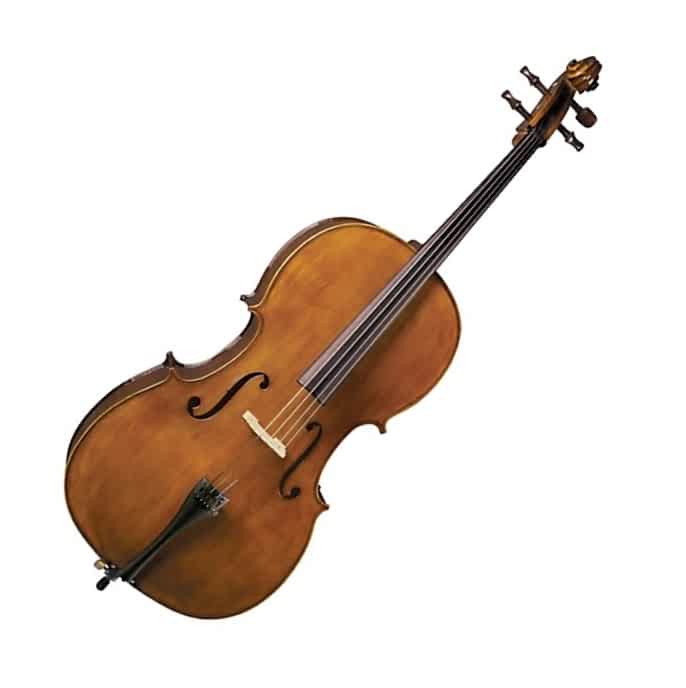
PERFECT FOR: Beginners and Students
FEATURES: Hand-carved from spruce and maple wood
OTHER INFO: Ebony fingerboard
Cremona SC-165a
When you check the price above, you’ll see there are loads of great places to buy this item. Our personal favorite is Gear4music.
It is the largest music retailer in the UK and fast becoming the most respected online music shop in the US too. Their customer service is excellent, they have competitive prices, really fast shipping, and usually have the longest guarantee.
Most professional musicians use Gear4music, so there is no reason why you shouldn’t too!
- Swiss-style pegs
- Balanced bow for easy playing
- Quality wood construction
- Lightweight composite tailpiece
- None
The professional musician who wrote this article combined many things,
from the product build, manufacturer’s reputation through to feedback
from other users, to create our famous TedScore™.

PERFECT FOR: Beginners and Amateurs
FEATURES: Music stand and cello stand included
OTHER INFO: Comes with a free padded carrying case
Merano 4/4 Size Cello
When you check the price above, you’ll see there are loads of great places to buy this item. Our personal favorite is Gear4music.
It is the largest music retailer in the UK and fast becoming the most respected online music shop in the US too. Their customer service is excellent, they have competitive prices, really fast shipping, and usually have the longest guarantee.
Most professional musicians use Gear4music, so there is no reason why you shouldn’t too!
- Two sets of extra strings
- Quality bow
- High-quality cello construction
- Complete accessories
- None
The professional musician who wrote this article combined many things,
from the product build, manufacturer’s reputation through to feedback
from other users, to create our famous TedScore™.
Advantages and Disadvantages of Playing the Violin
Advantages
-
Playing the violin requires focus, memory, and coordination, which can help improve your cognitive function and overall mental health. It can also help strengthen your arm and shoulder muscles.
The violin is versatile and can be played in various genres, allowing you to express yourself creatively and explore your musical interests.
The diverse repertoire available to violinists means they are spoiled for choice when challenging their skills. Violins are smaller, more portable, and have a range and tone similar to the human voice, making them a practical choice for musicians.
Disadvantages
-
Playing the violin requires patience, dedication, and practice to master the techniques and skills needed to play the instrument well. It is also physically demanding and may cause discomfort or pain in your neck, shoulders, or back. However, proper technique and posture can help alleviate these issues.
Lastly, violins require regular maintenance, including tuning, cleaning, and occasional repairs. This can be time-consuming and expensive.
Our Recommended VIOLIN
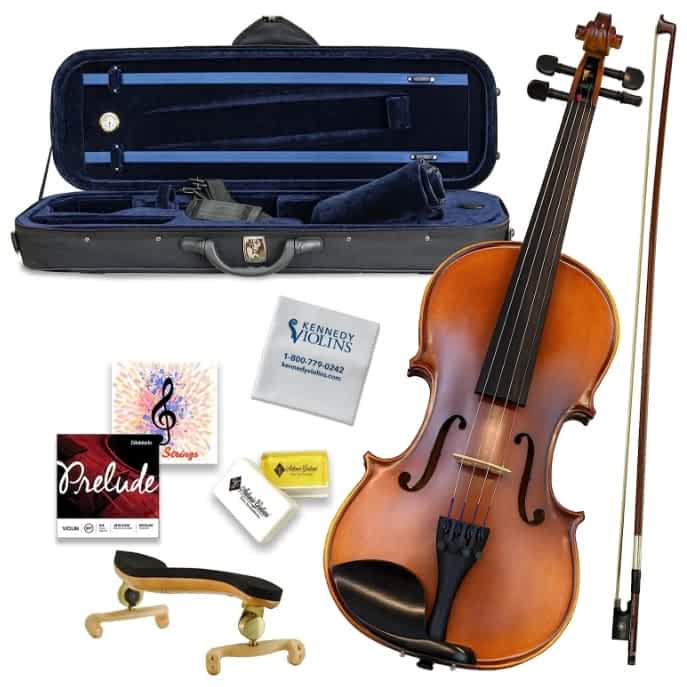
PERFECT FOR: Beginners to professional
FEATURES: With a digital clip-on tuner
OTHER INFO: Solidly carved maple and spruce solid wood.
Ricard Bunnel G2 Violin
When you check the price above, you’ll see there are loads of great places to buy this item. Our personal favorite is Gear4music.
It is the largest music retailer in the UK and fast becoming the most respected online music shop in the US too. Their customer service is excellent, they have competitive prices, really fast shipping, and usually have the longest guarantee.
Most professional musicians use Gear4music, so there is no reason why you shouldn’t too!
- Fingerboard is made from solid wood ebony
- High-quality Mongolian horse-hair bow
- Oil-based finish
- It has a fantastic, rich, mellow, warm tone
- It may seem heavy to some
The professional musician who wrote this article combined many things,
from the product build, manufacturer’s reputation through to feedback
from other users, to create our famous TedScore™.
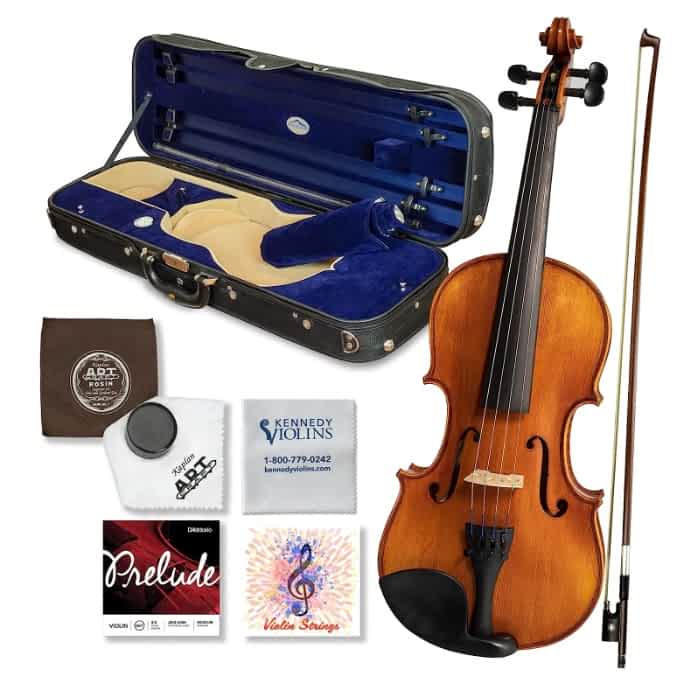
PERFECT FOR: Beginner to Professional
FEATURES: Kaplan aircraft bow rosin
OTHER INFO: With an extra set of strings
LOUIS CARPINI G2
When you check the price above, you’ll see there are loads of great places to buy this item. Our personal favorite is Gear4music.
It is the largest music retailer in the UK and fast becoming the most respected online music shop in the US too. Their customer service is excellent, they have competitive prices, really fast shipping, and usually have the longest guarantee.
Most professional musicians use Gear4music, so there is no reason why you shouldn’t too!
- With wood-shell case
- Has a lifetime warranty
- Responsive Brazilwood Bow
- Hand-carved body
- Doesn’t come with a shoulder rest
The professional musician who wrote this article combined many things,
from the product build, manufacturer’s reputation through to feedback
from other users, to create our famous TedScore™.

PERFECT FOR: Beginners
FEATURES: Crafted in different sizes
OTHER INFO: With an extra bridge and adjustable shoulder rest
Mendini MV300 Solid Wood Satin Antique
When you check the price above, you’ll see there are loads of great places to buy this item. Our personal favorite is Gear4music.
It is the largest music retailer in the UK and fast becoming the most respected online music shop in the US too. Their customer service is excellent, they have competitive prices, really fast shipping, and usually have the longest guarantee.
Most professional musicians use Gear4music, so there is no reason why you shouldn’t too!
- Include a cake bow rosin
- Unbleached horse-hair bow
- Includes lightweight hard case
- Great entry-level price
- Need to be tuned in daily
The professional musician who wrote this article combined many things,
from the product build, manufacturer’s reputation through to feedback
from other users, to create our famous TedScore™.
Cello vs Violin
Summary
Deciding between the violin vs cello comes down to a few key differences. With its grandeur, the cello requires some space between my knees and serenades with deep, velvety tones. On the other hand, the violin is the lively sibling, fitting easily under my chin.
A cello is a large instrument with four strings. A violin has four strings that can be played by hand or with a bow. Plus, a violin is easy to carry around, making it a great companion for a traveling musician.
My cello’s sheet music covers a trio of clefs: bass, tenor, and treble. It’s a delightful challenge! Meanwhile, my violin sticks to the treble clef, keeping things streamlined but simple.
Nifty Breakdown:
- Cello: larger, deep tones, seated play, multiple clefs.
- Violin: portable, higher pitch, shoulder rest, treble clef.
Ultimately, the decision comes down to size, sound, and playing style. Whether I’m drawn to the cello’s deep embrace or the violin’s lively charm, my personal melody decides. Happy playing!!
Wait, there’s more!!!
Are you ready to unleash your inner musician? Look no further! Check out How To Play The Cello, where you can play beautiful melodies and create music that moves people to tears. So, grab your bow, loosen up your fingers, and get ready to embark on a musical adventure like no other. Let’s learn how to play the cello!
FAQ's
Playing the cello is easier than playing the violin because of the more natural and relaxed playing position. However, both instruments have their own challenges, such as the difficulty of the thumb position in the cello, which can be tricky for many students.
Both the violin and cello have unique and beautiful characteristics. If you enjoy high-pitched sounds and soloing, the violin is better for you. However, the cello suits you better if you prefer warm, mellow tones and less soloing.
Learning to play the cello when you’re a violinist is not impossible; the same goes the other way around. The cello is a stringed instrument that belongs to the violin family with four strings, tuned at low to high notes.
Also, violinists have the foundation to learn to play the cello since they know the basics of producing good sound and playing in tune. They also have a good sense of the bow arm and understand the rhythmic phrasing necessary to play both instruments.
The cello produces a mellower and warmer sound than the violin due to its larger size and broader strings. The cello’s timbre is more resonant, making it seem more sonorous and more profound than the violin’s sharp and piercing sound. While the violin is better suited for solo and chamber music because of its higher range, the cello can be heard in various musical genres, including classical, jazz, and popular music.
If you’re already good at playing the violin, why not try the cello? While the two instruments have unique, they share much in common regarding technique and musical theory. Their close relationship often means that if you’re good at one, you’ll likely be able to pick up the other easily.
Of course, practice makes perfect, but the good news is that you’re already halfway there! Plus, with fewer cello players in the game, you’ll have a better chance of standing out and making a name for yourself. So, why not take the plunge and explore the world of the cello?











There are many inconsistencies with this article, but one detail irked me especially. The violin, viola, and cello all evolved from the viola da braccio family, whereas the double-bass or upright bass evolved from the viola da gamba family. The shape of the instruments are the biggest indicators of their differences. The bass still retains the iconic da gamba shape, albiet bigger in size. The way the bow is held is also another telltale indicator. The da braccio family of instruments hold their bows with the hand on top, whilst the da gamba family of instruments hold their bows with the hand on the bottom. Guess what instrument still has their bow held from the bottom? Another difference between the da braccio and the da gamba family is the tuning. The da braccio family tuned in fifths; the da gamba family is tuned in fourths. You’ll never believe what instrument is tuned in fourths . . .
So no, the bass is not part of the “violin” family. Sorry bassists, but you play the weird stepsibling of the violin family.
Well thank’s for that detailed response regarding the article! Fascinating!!!